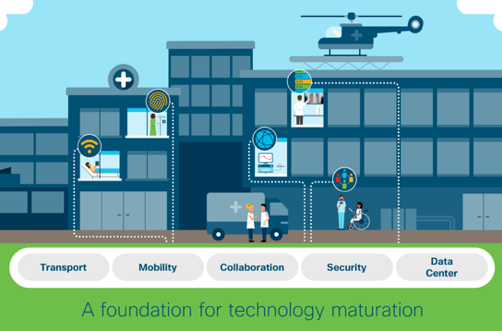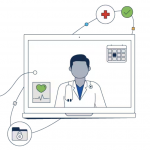Today we are rapidly approaching a new reality that none of us has lived in before. And that reality is that for the first time, technology isn’t the barrier to progress.
Is cost a factor? Yes.
Complexity? Almost certainly.
Government regulations? Definitely.
But if you put those aside, the technology we have today can accomplish almost anything anyone can dream of. And as much progress as we have made already, technology continues to march further, faster.
What is standing in the way of innovation?
The application of technology in healthcare has its limits. Sometimes that stops us from trying to innovate. Privacy regulations, like GDPR and HIPAA, are often barriers to progress. Government regulations, such as FDA requirements, are another. Data integrity is yet another great example.
Something as simple as human identity across large populations can be difficult for technology to get right. There are advancements, like biometrics, but many industries including healthcare hasn’t adopted those technologies as fast as other industries. I can log into my investment account with my voice, but I still fill out paperwork every time I visit the doctor. Other industries adopt innovation faster because of disruptive competition for customers. The complexity and regulation of healthcare has historically made it difficult for new competitors.
Disruptors are breaking through barriers
However, some new competitors don’t see those limits. They only see opportunities in healthcare. Opportunities for reducing or eliminating wait times, travel times, friction, and general frustration in the system. Here are four examples of disruptors in healthcare today:
Digital first, house calls next
Amazon’s pilot for employees in their Seattle HQ
A new venture promises to streamline healthcare by starting patient outreach with a chatbot. That patient interaction is escalated to a telehealth video visit on a mobile device, and then if the problem needs further diagnosis, a caregiver will do a house call.
One stop shop: Dog food, dentist, and diabetes care
Walmart in Atlanta and Dallas locations
Another example is centralizing consumer care services into a single location for convenience. Primary care, chronic care, dental care, even mental health while you pick up your prescriptions. And groceries.
Chronic care everywhere
CVS HealthHUBs in Houston
In three stores in Houston, CVS took more than 20% of their retail products out of their stores, traded it out for medical products like sleep apnea masks, doubled their capacity for on-demand primary and chronic care, and created a position called the ‘care concierge’ that guides patients as they walk in the door. CVS plans to expand to another 750 locations in 2020.
Silver Tsumani home health
Best Buy investing in wearables
Here’s another example, but this one is on the opposite side of the care continuum. They see consumption of healthcare services and devices growing exponentially in the senior care sector. Telehealth, home monitoring, fitness, and wearables. They’ve spent a billion dollars in the last year alone on healthcare-related acquisitions.
Identifying the common threads of innovation
There are two interesting common threads here across each of these examples. One is how the care continuum is getting disaggregated. Historically, the patient experience started with patient intake and primary care, imaging and lab orders, then a specialist referral. Maybe a surgical intervention is needed, and then follow up care. It is a care experience created by the healthcare system, on their terms. Many would argue that there isn’t anything about that process that is customer focused, or convenient, or patient-centric.
The second common thread among all of these examples is convenience. Competitors are taking the non-acute segments, where patient experience is lagging, and complexity is low. These retailers are taking their own unique assets and looking at new ways to leverage them, such as a large brick and mortar footprint with Walmart and a high frequency of patient touchpoints, like CVS.
These companies are looking at a part of the care continuum and saying: “This is broken. We can make it convenient and easy. Pick up some milk, a prescription, a flu shot, and a sleep apnea diagnosis. In Amazon’s case: “Don’t come to us, we will come to you.” Overall, the approach is: “We don’t have to do it all, but we think we can do THIS part better.”
Change is hard. Transformation can be disruptful. It took healthcare over a decade to fully adopt Electronic Health Record technology. And even then we didn’t really improve the process. We digitized it. And most patients would make the argument that their care isn’t easier, faster, or more convenient. And that is where I think we have to focus our efforts if we want to improve healthcare delivery.
Re-engineering process first, technology second
The biggest opportunity we have today to truly change healthcare delivery is process re-engineering. Process focused on a patient-centered experience. Redesigning patient experience at the point of a consumer decision. Where patient experience is a conscious choice and a vote for a better customer experience.
In all transparency, I am a process optimizer. I think about these things all the time. You know, one of those people that whenever they stand in any line they start to re-engineer the process – airports, restaurants, stadiums, doctors’ offices. I do time studies in my head at Chipotle, while waiting at TSA. Honestly, it’s exhausting! And you can bet it’s often exhausting for those around me, as I am always looking for a better customer experience in this digital world.
And that is what this article is about: how technology PLUS process equals digital transformation. And specifically, how important authentic process engineering is to creating a better experience. But why do so many organizations fail in their digital transformation efforts? My hypothesis is that most established organizations have the transformation equation out of order. They are starting with the technology first and then applying it to an existing, flawed process. When that happens, a fundamental equation doesn’t add up. Process transformation needs to be the first step BEFORE technology is added to the equation.
The order of operations here is really important. A new improved and customer focused process PLUS Technology is required for a transformation that can scale.
What happens when you do the equation out of order? Pilot purgatory. More often than not, when the technology is applied without re-engineering the process, the result is low technology adoption and shelfware. Everyone has a bit of shelfware in their company. Shelfware is any technology that a company buys with the right intention and the promise of a better outcome but isn’t deployed or adopted by the organization at scale. Any technology must be customized to enable your NEW process to impact customer experience. And your new process has to be customer focused first. An interview from 1999 with Jeff Bezos is a great time capsule and insight into Amazon’s approach to customer focus.
My key takeaways are to invest in a company with an obsessive focus on customer experience. Invest in assets that improve customer experience. Jeff Bezos also talked about some of these same principles that are important in a better customer experience. Price transparency. Ease of use. More Information to make decisions.
Insights from a bad experience: A taxi ride
Recently, I stepped off a flight from Nashville to New Orleans. I walked out of baggage claim and, while I usually would call an Uber or Lyft, the taxi line was right there outside of baggage claim, with only a few people in line ahead of me. My phone was dead, so I told the taxi attendant my hotel and got in my yellow taxi.
The experience wasn’t good.
The car was dirty and old. I couldn’t charge my phone. We hit traffic. I had no idea when I would get to my destination or why it was taking so long. The ticker kept ticking, and it was getting expensive. And when I arrived, I used a credit card to pay via the self-service pad. It wasn’t easy to use, so the transaction accidentally went through without a tip. The driver was upset. I was upset. No one was happy. And I said never again… It just wasn’t worth it when there are other options. Uber was better.
Why Uber is better
While waiting in another line, I came up with a framework – six fundamental questions that define exactly why Uber was better than a taxi:
1. Is it available when and where I want it? On demand – consumers expect services to be available when and where they need it.
2. Is this a fair cost or a good value? Price transparency – is the value I get worth it to me what I am about to pay? Do I know how much it is going to cost me before I commit to the purchase?
3. Can I choose my level of experience? Customized and personalized – I can choose an uber XL, black car, stretch limo or shared ride. I am in control of the level of experience I want or need at any given time.
4. Do I know how much time this will take? Process transparency – I am able to know how long it will be before my ride gets here, when I am expected to arrive at my destination and how far along I am in the process.
5. Is it personal? Where is my data? Data traceability – I have access to my data – my last 10 rides, where they were going to, who drove me, what kind of car I was in, what I paid. All at my fingertips.
6. Is the experience easy to do over and over? Convenience – And the next ride I need is only a few taps away.
These six questions for typical taxi services were usually no. Uber took the opportunity to bring a new experience to the world.
And when I built this framework on a whiteboard, I realized that hidden in these questions were six keys to digital transformation. Six critical customer careabouts in this digital world that deliver a better customer experience. That instead of Uber and Taxi, this was the difference between digital and analog. It was the difference between today and tomorrow. And if you aren’t delivering these outcomes in your process today, then this was the blueprint for how any competitor will disrupt your business model.
Applying 6 keys of digital disruption to healthcare
Think about your customer experience process today for any part of the continuum of care, such as primary care, appointment scheduling or outpatient surgery to name a few. Do they meet these hurdles of digital transformation? I would submit that almost every single one of these questions need to be addressed for true digital transformation. And the technology you choose should support these 6 customer priorities. This is where your competitors are going to focus their attention as they look for ways to chip away at your business model. And it is true for every industry.
Let’s look at a great example, Mercy Health, and their approach to telehealth. Instead of piloting a technology, giving it to a team as a side project, they started from scratch. They looked at how their internal customers could be helped with virtual services. They saw the opportunity and created a new process. A new building. A new business opportunity. They created a process that other healthcare organizations can subscribe to as a new revenue model. They created Mercy Virtual. A four-story building without any patients. Over 10 different service lines from eICU to home health monitoring. While most all other organizations were doing pilots with the existing process in a specific department, Mercy started from scratch with a customer-focused outcome in mind and not only built a new process but a whole new revenue stream.
Cisco’s approach to digital transformation
At Cisco, our focus is really about enabling a secure, intelligent platform that provides the foundation for digital healthcare. We have a unique perspective on digital transformation. Cisco sees every industry, from retail to mining. We see an industry perspective across 10 different technology market segments – from data center, to security, to collaboration, to networking. We are often the technology that enables the transformation. We wrote two books on digital disruption because our technology is at the center of it.
And we’ve worked with industry leaders to help shape the HIMSS Analytics INFRAM – a maturity model that defines your technology needs based on a healthcare systems roadmap. This is a great first step on your journey toward understanding where your technology infrastructure capabilities are today and where you need to be tomorrow to reach your strategic and clinical business goals.
Everything you do today and tomorrow in healthcare — from managing IoT medical devices to implementing AI decision support — depends on a strong technology infrastructure foundation. All your systems – network, mobility, collaboration, security, data center — need to work together seamlessly to accelerate innovative care and take on new challenges.
Digitizing an existing process isn’t transformation. Digital transformation is delivering a new customer-centered process through better technology. Simplicity. Transparency. Convenience. Availability. Traceability. And always available anywhere, anytime. This is the new normal for consumer expectations. For all of us in healthcare, that is a tough pill to swallow.




Digital transformation helps us make the process easy as well to priorities the work accordingly. Like you said “The biggest opportunity we have today to truly change healthcare delivery is process re-engineering. Process focused on a patient-centered experience. Redesigning patient experience at the point of a consumer decision”, process re-engineering helps us reduce the existing limitations and develop the technology for the future experience.